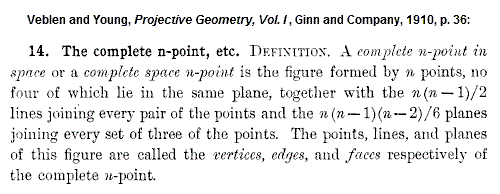… And the history of geometry —
Desargues, Pascal, Brianchon and Galois
in the light of complete n-points in space.
(Rewritten for clarity at about 10 AM ET April 29, with quote from Dowling added.
Updated with a reference to a Veblen and Young exercise (on p. 53) on April 30.)


Veblen and Young, Projective Geometry, Vol. I ,
Ginn and Company, 1910, page 39:
"The Desargues configuration. A very important configuration
is obtained by taking the plane section of a complete space five-point."

Each of figures 14 and 15 above has 15 points and 20 lines.
The Desargues configuration within each figure is denoted by
10 white points and 10 solid lines, with 3 points on each line and
3 lines on each point. Black points and dashed lines indicate the
complete space five-point and lines connecting it to the plane section
containing the Desargues configuration.
In a 1915 University of Chicago doctoral thesis, Archibald Henderson
used a complete space six -point to construct a configuration of
15 points and 20 lines in the context not of Desargues ' theorem, but
rather of Brianchon 's theorem and of the Pascal hexagram.
Henderson's 1915 configuration is, it turns out, isomorphic to that of
the 15 points and 20 lines in the configuration constructed via a
complete space five -point five years earlier by Veblen and Young.
(See, in Veblen and Young's 1910 Vol. I, exercise 11, page 53:
"A plane section of a 6-point in space can be considered as
3 triangles perspective in pairs from 3 collinear points with
corresponding sides meeting in 3 collinear points." This is the
large Desargues configuration. See Classical Geometry in Light of
Galois Geometry.)
For this large Desargues configuration see April 19.
For Henderson's complete six –point, see The Six-Set (April 23).
That post ends with figures relating the large Desargues configuration
to the Galois geometry PG(3,2) that underlies the Curtis
Miracle Octad Generator and the large Mathieu group M24 —
See also Note on the MOG Correspondence from April 25, 2013.
That correspondence was also discussed in a note 28 years ago, on this date in 1985.























